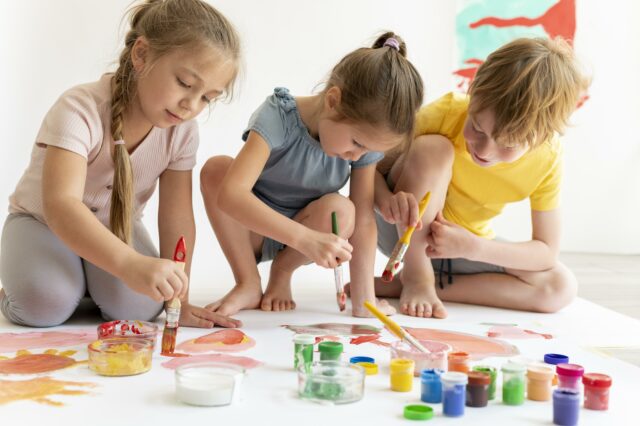
Parenting should not only be about imposing lisocial-and-emotional-benefits-of-arts-and-crafts-in-early-childhoodmits and discipline but also ensuring a healthy physical, cognitive and emotional development.
According to the artist and educator Felipe Sepúlveda, from birth to seven years old, children need all kinds of sensory stimulation, since they are at a formative stage. Artistic experiences, in any of its forms (whether painting, dance, theater), provide different tools that play an important role in the integral learning process.
Anthropologist and kindergarten director Maritza Díaz explains that although artistic activity is positive at all ages, it is advisable to work on it from the very first years. This does not imply that kids will become artists in the future; it is a matter of promoting their personal and societal growth.
As the importance of art and craft in early childhood education grows, the education of both parents and teachers must be adapted to the developmental stage of the infants. Knowing their needs is fundamental in deciding an artistic practice and the appropriate tools so they can express themselves.
Many parents will then find both social and emotional benefits of arts and crafts to their children.
From the age of two, they begin to play using only their hands. At three, they can use grasping utensils such as crayons and at four, their awareness will allow them to manipulate objects that require more control such as brushes.
Art can take many forms, the children interpret it in his own way. The important thing is that the adults generate appropriate spaces and encourage them to explore new experiences without interfering with their freedom of expression.
If they want to draw an elephant with ten arms, that’s fine. There are no limits to creativity, everything can be an artistic element and must be respected because it is a way of expression and communication.
Benefits of Arts Education
Art is a good strategy for education in all areas as it facilitates access to knowledge. Likewise, artistic practices are paths for participation, dialogue and collective construction. It should also be taken into account that it depends on the possibilities of each child. That said, the benefits of arts education are multiple:
1. Physical/cognitive functions:
- It stimulates creativity and imagination which influences the ability to solve problems
- It promotes concentration and the capacity of maintaining a sustained effort over time
- Handicrafts improve motor skills. As well, the forms allow them to know the dimensions and the materials stimulate the touch
- Facilitates the development of language and writing
- The preschoolers are able to recognize the physical space around them
2. Social functions:
- It encourages teamwork, tolerance and respect for their environment
- United Nations Educational, Scientific and Cultural Organization (UNESCO) has stressed that artistic learning fosters the development of civic values and the acceptance of one’s own cultural identity and the existence of other cultures.
3. Emotional functions:
- It helps to build sensitivity to the world by becoming aware of their emotions and sensations
- It allows them to create stories and to interpret their own vision of reality. This enables them to form an opinion and develop their personal affinities
- They experience feelings of satisfaction with their own creative abilities. This increases their confidence and self-esteem
- It provides relaxation
- It enables self-knowledge and satisfies a spiritual need to express their inner world
Another very important fact is that art is a form of communication between parents and children. On the one hand, the infants are going to need help and this allows interaction, trust and cooperation to come into play. On the other hand, parents will be able to know what their kids are feeling since they show it through their creations before doing it verbally.
Tips on Art Activity for Preschool / Kindergarten
The influence of those who educate the minors is decisive at an early age. For this reason, artistic activity should be encouraged from home and school, but be careful not to impose it. The key is in the game: it is the main action to guide them in the learning process. If the work is done in the classroom, the students have to enjoy and learn to share the experience with their peers.
However, not all initial educational spaces are well trained in artistic disciplines. That is why it is essential for the parents to promote such activity in their homes. To encourage the kids to come into contact with art, they should consider the following suggestions:
1. Doing manual work at home, either in a particular corner or in open spaces. The important thing is that they feel comfortable.
2. Ideally, the children should have several options of tools but this is not necessary. Parents should also be creative.
3. Avoid pre-designed products such as coloring books as they limit the imagination. Instead, foment free drawing.
4. Boost curiosity.
5. It is recommended that parents also perform artistic activities that are not pure entertainment. In this way, kids will grow up used to a productive environment.
Last but Not the Least
However, established by ICOM (International Council of Museums), these spaces have all the necessary information available to the general public who do not opt for the above options.
In the end, the most valuable thing is that all children have a lot of fun creating their own art in the way they want. Ideally, parents should accompany them and have as good a time as they do. In short, the objective of art in the initial stage is to enjoy and strengthen the emotional bonds between them.
Original Source: https://www.ashleydrawing.com/post/social-and-emotional-benefits-of-arts-and-crafts-in-early-childhood-education